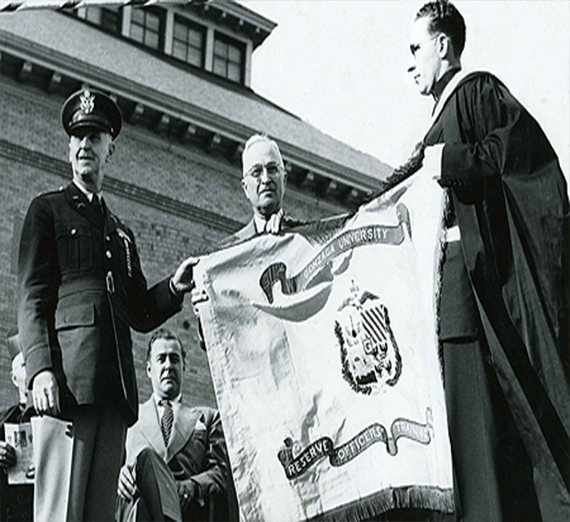Road to GU's 125th Anniversary: A Look Back at 1950-51

1950-51
Looking forward to Gonzaga University's quasquicentennial celebration (125th anniversary) in 2012, @Gonzaga continues its monthly series counting back to its founding year, 1887. This series began in September (2010) when we looked back six years to the 2004-05 academic year. Each subsequent monthly story looked back another six years. In this issue, we travel back in time to view highlights of the 1950-51 academic year.
By Peter Tormey
SPOKANE, Wash. — On May 11, 1950, President Harry S. Truman visited Gonzaga to receive a Citation of Merit, marking the first time in Gonzaga history that a U.S. president spoke on campus. Truman came to Gonzaga after attending the dedication of Grand Coulee Dam.
A platform rose up from the quadrangle lawn south of the Administration Building as more than 4,000 spectators gathered to watch Truman receive from President Francis Corkery, S.J., the award for his "moral stand in world affairs." Truman gave a 10-minute speech, emphasizing the equality and dignity of all people before God, and the need to eliminate injustice to achieve lasting peace.
In spring 1950, Gonzaga was co-champion of the National Collegiate Boxing tournament. Coached by Joey August, Carl Maxey (who went on to a famed legal career) was the 175-pound champion; Eli Thomas was the top middleweight champion; and Jimmy Reilly added team points in the semifinals. Eligibility changes by the Pacific Coast Conference and a short schedule forced Gonzaga in 1952 to discontinue boxing. Gonzaga eliminated boxing in the year it was a favorite for national honors again.
Gonzaga had begun admitting female undergraduates in fall 1948, which created logistical problems that had to be addressed. A new lounge for women was built in the Administration Building (College Hall) in 1950. There were no women's residential facilities until Crimont Hall (a house) opened in 1951. Before that, female undergraduates had to live with relatives. After Madonna Hall was built in 1954, the temporary women's residence in Crimont was replaced in 1965 with construction of Crimont Hall on the site of the original house.
Women had attended Gonzaga's professional schools — law, education, nursing and others — before they could attend undergraduate courses. Female undergraduates participated in recreational activities, not intercollegiate sports except for the ski club, which allowed four women to participate in Gonzaga's first year of coeducation. In the late 1950s, establishment of the Women's Athletic Association (WAA) enabled women students to play basketball, volleyball, golf, softball, tennis, archery and swimming.
The 1950s also brought the hiring of female faculty and administrators. Catherine Rochlitzer was the first dean of women (1949-53). Before the 1950s, a few women taught classes — as instructors — in music, English, and other subjects. One of the first women to earn the rank of assistant professor was Lucille Lake, who taught English in the mid-1950s. Two other pioneering professors were Lydia Savedoff, who became an assistant chemistry professor in 1956, and Marilyn Stanton, who became an assistant biology professor in 1960 after serving as a piano instructor.
In response to increasing needs of female students, Gonzaga announced in fall 1951 formation of the Spurs, a national collegiate women's service group affiliated with the Intercollegiate Knights. Initially, the organization accepted 35 freshmen and sophomores. The group broke from the National Spurs in 1989, was forced to change its name and became the "Setons" to honor St. Elizabeth Ann Seton who exemplified leadership and service.
With the School of Engineering running out of room in the Administration Building, a new engineering building was built and dedicated in 1949 named Dillon Hall, after Gonzaga President Francis C. Dillon, S.J. Faced with Indiana limestone, the $500,000 structure housed expensive equipment for chemical, electrical, mechanical and civil engineering labs on its main floor. Its upper floors housed classrooms, lecture halls, and faculty offices. The building was renamed the Herak Center for Engineering in 1984 to honor major benefactors, Donald and Carol Herak. The School added the computer science program and changed its name in 2006 to the School of Engineering and Applied Science.
